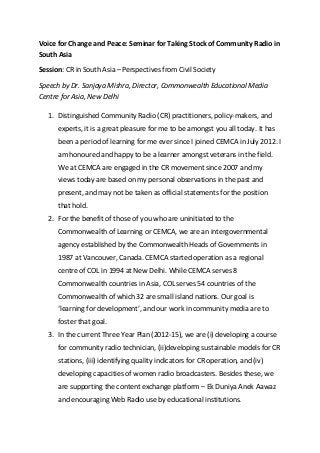
Speech at the UNESCO Chair and AMARC Seminar on Voices of Change and Peace
- 1. Voice for Change and Peace: Seminar for Taking Stock of Community Radio in South Asia Session: CR in South Asia – Perspectives from Civil Society Speech by Dr. Sanjaya Mishra, Director, Commonwealth Educational Media Centre for Asia, New Delhi 1. Distinguished Community Radio (CR) practitioners, policy-makers, and experts, it is a great pleasure for me to be amongst you all today. It has been a period of learning for me ever since I joined CEMCA in July 2012. I am honoured and happy to be a learner amongst veterans in the field. We at CEMCA are engaged in the CR movement since 2007 and my views today are based on my personal observations in the past and present, and may not be taken as official statements for the position that hold. 2. For the benefit of those of you who are uninitiated to the Commonwealth of Learning or CEMCA, we are an intergovernmental agency established by the Commonwealth Heads of Governments in 1987 at Vancouver, Canada. CEMCA started operation as a regional centre of COL in 1994 at New Delhi. While CEMCA serves 8 Commonwealth countries in Asia, COL serves 54 countries of the Commonwealth of which 32 are small island nations. Our goal is ‘learning for development’, and our work in community media are to foster that goal. 3. In the current Three Year Plan (2012-15), we are (i) developing a course for community radio technician, (ii)developing sustainable models for CR stations, (iii) identifying quality indicators for CR operation, and (iv) developing capacities of women radio broadcasters. Besides these, we are supporting the content exchange platform – Ek Duniya Anek Aawaz and encouraging Web Radio use by educational institutions.
- 2. 4. Community Radio in India has a long way to go. We only have 140 odd CR stations. For a country as big as India, we need CR stations at panchayat level. To see CR at the panchayat level, there are several things to be done. The existing CR stations are also plagued with several problems such as technical break-down, programming, community participation, sustainability, etc. Overall, the scenario is complex, when the complex licensing process. Sometimes, it looks as if we are trying to dissuade people from applying for license. 5. While the current policy has relatively served well, a. there needs to be greater coordination and fast track processing of applications; b. policy also needs to consider overall contexts and philosophy within which CR is situated. We must see CR as infrastructure for national development that as a tool for information, education and entertainment will provide a platform for freedom of expression’ of local communities, and also help preserve languages and culture. c. Can we think of extending the eligibility for licensing by reducing the number of years in operation for NGOs? Can a new NGO created exclusively for CR get licence? Yesterday, I received a call from a Kolkata based NGO that is in operation only for one year, and they can’t apply even if they are financially sound and are committed to local development. Can we open up the sector further to allow the community to start CRS rather than NGOs doing it for the communities? d. Funding is a perennial problem of CR stations. Definitely govt support to sustain is welcome. But, right checks and balances are required not to put the autonomy of the communities in danger.
- 3. e. Self-regulatory mechanism is the most important aspect of any media. To make the CR operators aware of their responsibilities is probably something that organizations like CRF can take lead. If this is not done at the earliest, it may be imposed. f. Capacity building is definitely a common concern for all CR sector, as the communities need to be empowered with media information literacy. We at CEMCA have been focusing on this aspect, and currently developing a course for community radio technicians that will be offered as Open Educational Resources for self-learning and certification by Open Distance teaching organizations. g. We believe that content developed by CR sector should also be made available in open licences to be appropriately reused by many stations. h. Communities should also be engaged in defining what constitutes quality in CR. The UNESCO chair on Community Media is engaged in developing a continuous improvement framework of quality assurance of CR stations. i. The CR sector has passed the stage of emergence, seen the expansion, and now it should mature. May be it is too short a period, but we must learn fast to grow and mature. j. We at CEMCA also work in Bangladesh, Sri Lanka and Maldives; the situation there is also almost similar. Network like AMARC has a strong role to play in taking CR movement to a level of maturity. 6. I take this opportunity to thank you all, especially Vinod for giving me this opportunity to be here and to Iskra for the connection. Thank you all for your attention.
